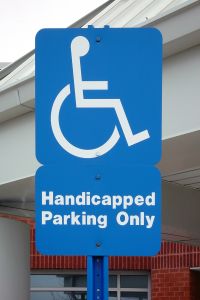From the Disabled Travelers Mailbag: Comparing Accessibility: Europe and the U.S.
Posted December 24th, 2010 in helpful information
In many European cities, you won’t have to feel homesick for equal access.
Photo by: Kenn Kiser (Stock Exchange)
Howdy, all!
Today, we’ll be delving into the Disabled Travelers mailbag for the first time in a long while.
Feedback is one of my favorite things, and it always brightens my day to answer a question: luckily, I came back to a couple of doozies after my hiatus!
Spinning off from a question by Rebecca, I’d like to compare accessibility in the U.S. and Europe in a few respects. Let’s roll …
A while back, Disabled Travelers viewer Rebecca asked me a great set of questions.
“Have you found it easier to travel in Europe or the United States? Are attitudes much different on either continent? Do you find more wheelchair lifts, wheelchair accessible vehicles and the like in some cities more than others?”
Now, you can see my original answer in Wheelchair Accessible Bus, Charter, and Train Options in the United States. Since I’m sure this is on the minds of plenty of disabled travelers and their travel companions, I thought I would expand on it a little. Let me break it into sections …
Q: Have you found it easier to travel in Europe or the United States?
A: Europe and the U.S. each have their own advantages as far as travel goes. The U.S. benefits from terrific disability rights laws – though no area of the States is “perfect,” accessibility is important. Many European nations have their own laws to this effect, but every country is different. Conditions can vary by region in a single country, too – just as they do here – especially when you consider many European cities have historic structures hundreds of years old in addition to modern buildings.
That said, most of Europe has a huge advantage that the U.S. lacks: public transportation. Not all public transit is created equal, but having the option is a tremendous help, versus the challenges of renting a vehicle. I think a U.S. visitor to major cities in many European countries, would find the going pretty easy, with the right preparation. But it’s a mixed bag, and things are changing quickly for the better in many areas. That’s precisely why the Disabled Travelers blog exists, in part – we sort through all the news for you.
Q: Are attitudes much different on either continent?
A: While disabled travelers do sometimes have trouble with airlines, accessible hotels (that turn out to have a loose definition of “accessible”) or other aspects of travel, it’s been really rare in my experience to hear a horror story about being ill-treated by average folks in the U.S. or Europe. In most of the places I’ve traveled, including the UK, Ireland, Germany, and Sweden, attitudes were good even where accessibility was not. Of course, this might depend just as much on how welcoming people are toward tourists.
For my part, easily the most helpful and welcoming strangers I’ve ever run into were those in Sweden, specifically Stockholm. It was impossible to even look at a map for more than a moment or two without being questioned by a helpful local – and because English is part of the school curriculum in Sweden, the language barrier is much lower. I found even the traditionally retiring Brits were often helpful and curious about visitors.
Q: Do you find more wheelchair lifts, wheelchair accessible vehicles and the like in some cities more than others?
A: Well, don’t take my word for gospel, but I think I’ve noticed a pattern where this is concerned. As I said in my original response to Rebecca, major cities and the areas around tourist attractions do usually seem to be best outfitted for accessibility, and that holds true in both the U.S. and Europe. But as far as really great accessibility goes, there are really two attitudes that seem to do it:
One, “global cities” like New York, London, Tokyo, and Paris that have a place on the world stage and a certain “image” to uphold tend, generally, to have the best accessibility (despite their urban challenges.) Now, things can be uneven: New York could use better mass transit for handicapped visitors, and not all of Paris’ landmarks are accessible – to name a few examples. But, as intimidating as they might be at first, you can rely on a capital city to be a pretty good barometer of accessibility. If the capital is rough, well …
Two – and I discovered this only as I continued writing the blog – there are areas that have lagged behind in accessibility and are now working hard to “catch up.” Several Eastern European cities fall into this category, and with luck, state capitals of Australia will soon follow. If a country’s English-language tourism site includes a clear, comprehensive section on accessibility, you can suspect they’re trying to build trust. (Hopefully, that trust comes with ramps.)
I hope this overview helps! Now, it being Christmas Eve and all, it’s high time for me to scoot. But you have a very merry holiday, and we’ll see you again at the blog in time to ring in the new year!
Si
